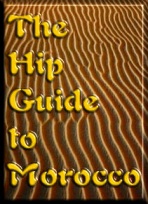  Chefchaouen Chefchaouen
by Red Bud Until 1920 Chefchaouen was closed to Europeans. Now that it's opened it's gates, the outside world has influenced the town. Fortunately it has retained much of it's low key charm and is one of the most friendly towns in Morocco.
|
|
Tips | Books | Postcards | More Hip Travel Guides |
The taxi ride from Ketama to Chefchaouen was accomplished in two stages, as the first driver didn’t have the police permit to allow him to drive all the way. So we went halfway to a smaller town and transferred to another taxi for the rest of the journey. Luckily, no police stopped us and we made good time.
We reached Chefchaouen around 3 in the afternoon, and checked into the Hotel Asmaa. The hotel is perched high above the town on a hill, with a panoramic view of the valley and village below. At about 5,000 feet above sea level, the figure-eight shaped town is surrounded by ancient walls, and has at least seven minarets for the faithful. We got a good earful of the calling to prayers over the next week as the wailing (or Lafki) carried right up the hill into our room five times per day. High above the town are the twin peaks of Chaouen – the goat horns – Chefchaouen means “look to the horns” - which has been a landmark for the Berbers for thousands of years. So naturally, a Kasbah and town grew there as an important trading and government center for the Rif Mountains.
The walls and gates of Chaouen are splendid, and the large Ras Alma Spring gushes out of the mountain inside the stone walls of the town. Not only is the town’s spring water pure and delicious right from the tap, the mountain air is so clean and crystalline that you can see forever, it seems, from up on the hill overlooking town. The view was so fabulous from our porch that we found the sipsi right away, and enjoyed a bowl of hash while gazing at the town below.
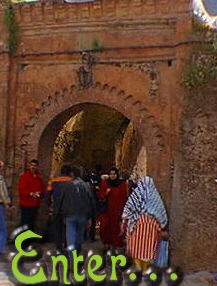
Entrance to the Medina
Having researched the town in a guide book and studied a map, we felt ready to go and explore. The desk clerk advised us to walk down thru the cemetery below the hotel and thru a gate in the wall, into the town’s medina directly. Otherwise, you have to take a taxi by road (about two kilometers) or walk down the road.
We set out for the shortcut, and a guide immediately glued himself to us as we left the hotel lobby. We were now stuck with Said for the afternoon. At least we had someone to explain the more interesting and obscure points of the town’s history to us. We were also shown some interesting places like the water-driven flourmill, the town’s spring, and the medina. After this mini-tour Said showed us to a restaurant for a fairly decent, but expensive Moroccan meal. We sent him on an errand while we ate – to get us some King Hassan hashish. Happily, he returned with the stuff and it was great!
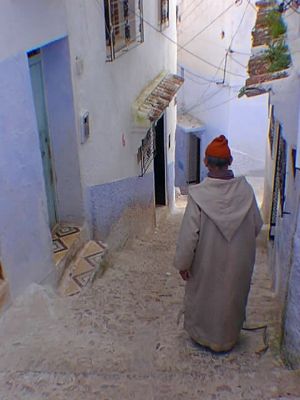
Chefchaouen Street
Walking through the ancient city of Chefchaouen was like stepping back in time a few hundred years… there was still a profusion of jellabah and burnoose wearing Berber men, and women in their traditional and very colorful costumes. The women’s hats are straw and decorated with brightly colored yarn balls like mini-pompoms, their dresses are striped and equally brilliant. Times are changing right in front of your eyes, however… most (if not ALL) of the younger generation are now dressed in western clothes, T-shirts, jeans and fancy running shoes. Chefchaouen is a relatively prosperous town, and the people love to show off their Western stuff. It seems every house in Chaouen has a satellite dish!
The next morning we awoke, with the windows wide open and fresh air gushing through the room. Feeling refreshed by our deep sleep, we wandered downstairs for breakfast. Breakfast at the hotel that first morning was memorable, and the view from the verandah spectacular. It seems we were the hotel’s only guests, as it was still off-season. How lucky can you get? We decided to enjoy a day at the hotel, smoking on the verandah and writing in the diary. We had snacks; nuts and dates, bread and juice, and proceeded to get “tranquillo”. Listening to the radio, we were treated to an hour-long speech by King Hassan (in Arabic). It turns out that day was the King's birthday and the entire country would celebrate for a week! In fact, the speech was on EVERY radio station on the dial. Moroccans love their King, and his photo smiles benignly at you in every public building.
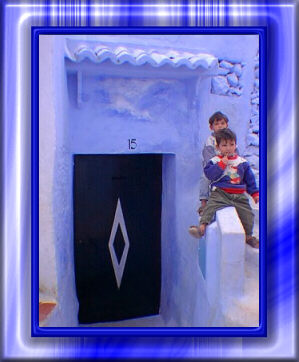
Powder blue houses add color
to the Chaouen medina
Around 2:30 in the afternoon we decided to go out and explore the town. As soon as we popped out the front door, Said, our guide from the day before was all over us. There was a waiting cab, and he got right in with us and immediately started hassling us for more money for the previous day’s efforts. A typically Moroccan scene, with everything subject to much arguing and changing of minds, even after the bargaining process has long since ended! After about 45 minutes of yelling at him, we finally got rid of the guy and set out on our own.
We really started to enjoy ourselves after getting Said the Guide to go away. Ambling unhurriedly through the medina, we strolled past the many colorful shops. When we arrived at the square by the Kasbah, we found ourselves in the middle of a huge event. It seems the entire town was there in the plaza to celebrate King Hassan's birthday. Huge tents were setup to shade the dignitaries and a special feast was laid out in one. Banners and flags with the Moroccan five pointed star on a field of red were flapping in the morning breeze. Large pictures of the King and his family were hung in the plaza. A band played live music and was followed by speeches. Everyone was dressed up for this occasion, and very cheerful.

Celebrating King Hassan's Birthday
We watched the proceedings for awhile then wandered down to the Avenue Hassan II, where everyone strolls with the "check me out" vibe. At the end of the street there's a round park surrounded by cafes. After shopping and finding some bargains on local handicrafts, we picked up some bread, fruit, nuts and drinks, and head back to the hotel. Upon arrival Primo discovers he has lost the chunk of King Hassan hash somewhere in town that day. What a tragedy! Oh well, we can get another one for $10 US.
The next day we found our way to town through the cemetery again, and got into the walled city through another ancient gate. Until the 1920’s access to the town by foreigners was strictly forbidden, as this was always a haven for revolutionaries and smugglers down through the centuries. The Kasbah has a most interesting dungeon, but unfortunately, the torture museum and display had been removed prior to our visit. The town is also an important center for weaving carpets, blankets and killim rugs, and each of us bought a killim to take home with us. Of course, the valleys around the Rif Mountains are filled with sheep for the wool; and hemp terraces for the kif, so the local Berbers have adapted well to their environment and their natural resources.
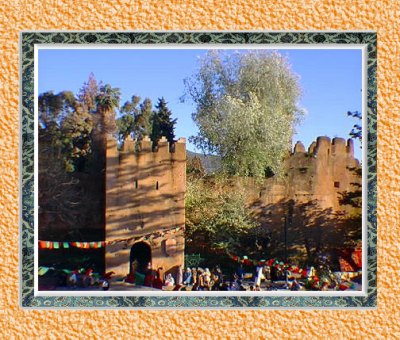
The Kasbah, Musee and Plaza
We met up later with a fellow named Omar, who had previously sold my friend a Killim rug. We found him in the street by La Poste, and as we were all hungry he recommended a restaurant, the Ras Alma. So off we went, and he drank ten beers while we had a meal of salad and Chicken Couscous. It was quite good, and after eating we followed Abdul Omar to the Pension Ahrazem, where we spent the rest of the evening talking with some French travelers who were busy swallowing mass quantities of hash wrapped in condoms, to take home with them. We got rather wasted, enjoying many sipsis and mint tea. The Moroccans all make this little joke when serving mint tea to strangers, they say “this is Moroccan whiskey . . . mint tea.”
Our "friend" Omar on several occasions dropped in at our hotel to partake of the refreshments available at the bar. These included some very good liquor, lively contemporary moroccan music and some very friendly women. He went out of his way to invite us to join him (and pay for his drinks of course). Both he and our guide Said also tried to line us up with the ladies.
Omar could drink all night long if he made enough off a naive tourist. We found him several times hungover the next morning. One Friday morning he smelled so bad I gagged and had to leave. He told us that, like many other Moroccans, he bathes only once a week, on Friday at the Hammam (bathouse) before going to the Mosque.
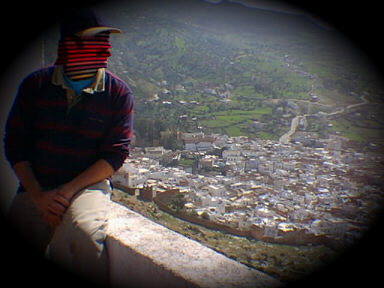
A Great View of Chaouen from
the Hotel Asmaa
At home in the Hotel Asmaa later we enjoyed some really fine music on my radio; the Strawbs, Janis Joplin, Sting, etc. Smoked some Hash Oil, and floated away on a cloud for the night. We both slept ten hours, floating high over Chefchaouen all night long. The next day we awoke to the sound of gunfire outside the hotel. This was very odd, since few Moroccans have guns. We went to the front of the hotel and witnessed a trap shooting contest going on. The local law enforcement types and some very well heeled civilians were enjoying their favorite sport. Why they choose the lawn of the Hotel for this event was unclear, perhaps it was the proximity to the bar where they could wash the gunpowder down.
During that week in Chefchaouen we had many good times, and met some outstanding local people. We were so entranced with the village that we spent a few days investigating the possibility of renting an apartment for a month or so and really relaxing. During that adventure we met some very helpful people, looked at some really crappy apartments, and a few really fine ones, but nothing worked out. We packed up a box of souvenirs including rugs, blankets and various presents, and mailed it back to our friends in civilization to hold pending our return.
Fine dining in Chefchaouen is almost non-existent unless you have your own kitchen and ingredients. The restaurants are all suffering from the same lack of imagination with food as does all of Morocco. You can only order three basic things in most Moroccan restaurants; Tagine, Couscous or Kefta. Couscous and Tagines vary only in whether you want chicken, fish or lamb as the meat; but if you are lucky, you can persuade a cook to prepare a vegetarian version of Couscous or Tagine. Kefta is always made with little lamb meatballs in a creamy sauce. They’re big on Lamb in Morocco. They have an entire festival for a week around Easter where they slit the throats of lambs and devour them at huge family reunions. Another special Moroccan dish is Pastilla. Pastilla is the famous Moroccan Pigeon Pie, made with a flaky crust and filled with nuts and Pigeon meat.
In Chefchaouen, the Ras Alma and the Aladdin restaurants provide a decent meal made in a clean kitchen, at a fair price. But it was the lack of imaginative food that made us decide to leave for Fez, a bigger city, with hopefully more to offer gastronomically.
On our last day in Chefchaouen we had to have a final adventure. We went all the way down a very steep hill to the bus station to get bus tickets to Fez the next day. As there were no taxis around, we decided to huff and puff our way up the hill back to town. A small van coming up the hill saw us and stopped, offering a ride!
Overjoyed, we tumbled into the back and the driver somehow got us, the van, and all its contents up this almost vertical street. As soon as we reached the top of the hill, a gendarme at a traffic circle saw us obvious tourists in a local car, stopped the van and proceeded to argue with the driver in Arabic. Then the gendarme hopped in, and off we went to the Hotel du Police, right around the corner.
We were politely escorted inside, and a suit-wearing detective proceeded to type up a report while asking us questions. We told the police that the driver had only offered us a ride, and never asked for money for the favor. The officer insisted it is only a minor infraction for the driver to be an illegal taxi, and the fine will be relatively small – about $40, but that was a lot to the Moroccan driver. Of course the gendarmes were not interested in tales of innocence, just filing the proper reports and following the correct procedures! We showed our passports, signed here and here (and about eight times more) on about ten copies sandwiched with old fashioned carbon paper!
By this time the poor driver was looking pretty irritated. So we decided to give the guy enough money to cover the fine, which was okay with the Gendarme in charge. He didn't care who paid the fine as long as “justice” was carried out. The French have left a lasting impression on the Moroccan bureaucracy. So with smiles on everybody’s faces after some cash passes hands, we finally got to leave and go back to the hotel, this time in a properly-licensed taxi.
When we finally took our leave of Chefchaouen, we got
another chance to bid farewell to our ever determined guide Said.
Of course he showed up again to harrangue us about money. He figured
he could get a few more dirhams out of us. Again he resorted to begging
and put on his best pathetic look. All we could do was laugh and
Primo called him a great actor. This made him smile. As we
got in the taxi he stuck his head through the window and begged again for
money. Then finally he resorted to the childish plea for a pen.
Unfortnately, I had already given mine away... Next stop, Fez
All images, artwork and content
Copyright 1999, Hip Inc.
